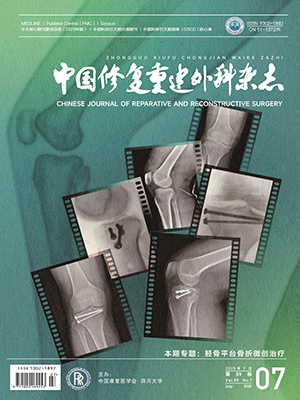Objective To study the feasibility of a new method for the cross-leg position maintained by the Kirschner wire internal fixation after the cross-leg flap procedure. Methods From December 2004 to October 2005, 5 patients (4 males, 1 female; aged 14-52 years) were admitted to our department, who suffered from the tibia exposure or the internal fixation plate exposure after operation because of the tibia fracture by trauma for 1-8 weeks. The soft tissue defects ranged in area from 2.4 cm × 2.0 cm to 4.2 cm × 3.0 cm. The soft tissue around the wound in the leg was too poor in condition to perform an operation of the local flap transplantation, but the wound and the tibia had no obvious infection, so an operation of the cross-leg flap transplantation was performed to cover the wounds. The operation was performed with the routine crossleg flap method introduced in the medical literature. After operation the cross-leg position was maintained through a simple internal fixation with two Kirschner wire, which were inserted through the tibia of the cross region of both thelegs, and layers of dressings were placed as a cushion between the crossed legsin case of the crushing skin ulcer formation. The effect of fixation, blood circulation in the cutaneous flap, and the stress of the pedicle were observed postoperatively. After 3-4 weeks the pedicle of the cross-leg flap was cut off; the crossed legs were detached and the Kirschner wire were pulled out. Results All the flaps survived with a good blood circulation and a low pedicle stress. The patients had a relatively comfortable position because all the areas of the legs could be allowed to make some motions except the cross-area ofthe legs. Another advantage of this fixation method was its convenience for observing the blood circulation of the cutaneous flap and for changing the dressings. Neither infection in the holes of the Kirschner wire nor crushing skin ulcer formation in the area of the cross-leg could be observed. The follow-up for 3-18 months revealed that all the flaps were in good condition with no edema, contracture or skin pigmentation. Conclusion The method of usingthe Kirschner wire to maintain the cross-leg position after the crossleg flapprocedure has more advantages than the plaster fixation. This improved method is simpler, and can achieve a tighter fixation in the crossleg area to maintainthe cross-leg position, allowing a micro-motion in other parts of the legs. The patients can have a relatively comfortable posture, and have a more convenient dressing changes and observation on the blood circulation in the flaps.
Citation: ZHAO Lin,WAN Lin,WANG Shuanke.. CLINICAL STUDIES ON MAINTENANCE OF CROSS-LEG POSITION THROUGH INTERNAL FIXATION WITH KIRSCHNER WIRE AFTER CROSSLEG FLAP PROCEDURE. Chinese Journal of Reparative and Reconstructive Surgery, 2006, 20(12): 1211-1213. doi: Copy
Copyright © the editorial department of Chinese Journal of Reparative and Reconstructive Surgery of West China Medical Publisher. All rights reserved




